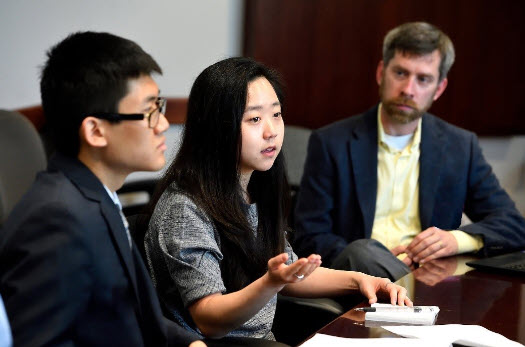The Center for Teaching Excellence and Innovation (CTEI) hosted a community conversation on Facilitating Difficult Conversations in the Classroom on Thursday,  November 9th, as a follow-up to our recent blog post on the same topic. The faculty panel included: Sherita Golden, Chief Diversity Officer at the School of Medicine & Hugh P. McCormick Family Professor of Endocrinology and Metabolism, Andrew Perrin, SNF Agora Professor and Department Chair of Sociology, and Mike Reese, Associate Dean of the Center for Teaching Excellence and Innovation & Associate Teaching Professor of Sociology. Caroline Egan from the CTEI facilitated the event.
November 9th, as a follow-up to our recent blog post on the same topic. The faculty panel included: Sherita Golden, Chief Diversity Officer at the School of Medicine & Hugh P. McCormick Family Professor of Endocrinology and Metabolism, Andrew Perrin, SNF Agora Professor and Department Chair of Sociology, and Mike Reese, Associate Dean of the Center for Teaching Excellence and Innovation & Associate Teaching Professor of Sociology. Caroline Egan from the CTEI facilitated the event.
Mike Reese opened the conversation by acknowledging that current events are an opportunity to apply course concepts but the instructor’s goal is to maintain civility on sensitive topics. He described some of the strategies he uses in his classroom, such as setting ground rules for class discussions. Reese explains the intentions of the rules to his students, which is to create a space that makes everyone feel comfortable participating. Some of his ground rules include:
- Support arguments with evidence
- Use ‘I’ statements – do not speak for others in the class
- Do not generalize about groups
- Allow students to speak without interruption (with caveat that the instructor can cut them off if they go on too long)
- Listen actively – be open to what others are saying
- Name-calling, sarcasm, inflammatory accusations are not permitted
Reese noted in his classes that historically the issue is less conversations becoming heated and more that students are hesitant to talk about politically-charged topics. He mentioned strategies to spark engagement, such as having students first work in small groups to discuss a topic. He also uses structured debate activities where students are assigned a specific perspective. In the debate activity, the pressure is taken off of the student since the role/perspective is assigned by the instructor.
In cases of traumatic events, Reese stated that instructors are not required to discuss the topic if they are not comfortable doing so, but should at least acknowledge the event. Research suggests students want events to be acknowledged, not ignored. Reese shared that a student this past week shared they don’t need to discuss the issue in every course, as the constant reminder may be counterproductive, but would prefer to discuss the event in courses that speak directly to the issue. The main message is be intentional about how you plan to discuss traumatic events and what boundaries you will place on the conversation before arriving to class.
Andrew Perrin continued the conversation by describing two principles he subscribes to:
- While all people deserve safety, no ideas deserve safety. The way we honor ideas is by submitting them to rigorous argument and evidence and testing them out.
- Emotions running high is not a reason to avoid discussions – it’s a reason to have better discussions. Explain and demonstrate to students how to listen thoughtfully to ideas and make judgments based on evidence.
While he supports Reese’s ground rules, Perrin takes a slightly different approach: he will often set the context for students, explain a scenario, and have them listen to their peers discuss the issue, recognizing their own ideas may turn out to be wrong. His pedagogical goal is to make sure that all reasonable ideas are raised so that they may be examined and challenged. At times Perrin will make arguments that he doesn’t believe in because he feels it’s important for them to be part of the conversation.
He believes most students politically are not committed either to the left or the right; they might be in between, they might not have thought about it much, or they might have mixed opinions.  The instructor’s job is to make sure the debate includes more ideas than just those from the 5-10% on the right and left. Perrin acknowledged that it might be hard to engage on difficult topics and students might be uncomfortable, but that is an acceptable outcome in a university classroom. He stated, “Too often we think the goal is to come to consensus. I think the goal is to understand why people feel the way that they do.”
The instructor’s job is to make sure the debate includes more ideas than just those from the 5-10% on the right and left. Perrin acknowledged that it might be hard to engage on difficult topics and students might be uncomfortable, but that is an acceptable outcome in a university classroom. He stated, “Too often we think the goal is to come to consensus. I think the goal is to understand why people feel the way that they do.”
Sherita Golden teaches medical students in a clinical environment as well as staff from all parts of the medical establishment. One of the issues that she addresses in her classroom is why we continue to see inequities in health, for example, the inequity of non-whites consistently having a higher prevalence of diabetes than whites. Golden explains to her students how historical discrimination and racism dating back to the time of enslavement have led to the current situation; eugenics theory suggesting the biological inferiority of non-white populations, trust violations by the medical establishment due to unconsented experimentation on enslaved and marginalized communities, as well as healthcare clinician bias against minoritized patients. These are all factors adversely affecting healthcare quality and access today. Another example is the historic practice of redlining, which made it more difficult for African-Americans to obtain mortgages and build wealth through their homes. Golden uses these historical contexts to explain the roots of current social movements to her students and health system staff.
Golden acknowledged that conversations can become politically charged and offered the following suggestions to help diffuse the situation:
- Acknowledge the humanity of the person speaking – listen with compassion and intent to respond rather than react.
- Commit to providing information to the person if you aren’t sure how to address the issue in the moment.
- Adopt a learner’s mindset:
- What is the historical context of the issue?
- What do you know about the lived experiences of those expressing the concern?
- How might you benefit from knowing more in your teaching/leadership role?
- Recognize that there are two sides to every story and the truth is somewhere in the middle.
The discussion continued with panelists taking questions from participants.
Q : I appreciate your [Perrin’s] idea of exploring other ideas of a particular subject, but at the same time, as we examine these charged issues and try to be objective, sometimes the discussion becomes politically neutral. I’m struggling with how I can resolve this issue of technical neutrality.
AP: I don’t think there are 2 sides, but actually 4, 5, or even more sides to every story. There are lots of different dimensions. One reason I don’t ask students to debate positions according to what I’ve set is because I think it is important for them to feel like what they’re saying matters and that they care about the issue. I’m not trying to say, “all ideas are fine” but instead, “all ideas deserve to be listened to.” I do think historical context is important, as well as real world evidence, so it’s important not to let them stick with things that aren’t true.
MR: The classroom space allows students to voice lots of different ideas, and sometimes students come out not knowing where to go from there. Here is where reflection may help – ask them to articulate how they have moved on a particular issue, if at all.
SG: The goal is not to come to a resolution, but help them improve their argument and use of evidence. I encourage students to read constantly – learning is a lifelong process. Reading will help me (and them) back up why I feel a certain way, with evidence.
Q: How do you create space to honor opinions that you feel are wrong or will harm others?
AP: The key is how we say things. There is a reason to challenge the idea because it’s there – it is also submissible to evidence. The person should be able to explain why they think what they think. It really is important for people to be pushed to explain why they think this or that, where is the evidence, what makes this true. I like to ask, “Is there anything you could learn that, if true, would end up changing your position on this?” It is important to distinguish between what is true and what people think. So even potentially harmful ideas need to be discussed, if only to bring evidence to show why they are harmful. That said, it is also important to protect students who may be hurt. I will sometimes remind students that there are probably other students in the room who may be negatively affected by what they’re saying.
Guest: This makes me think about a case in class: we watched a film about a kidnapped woman in China who was sold to a villager as a wife. In the film there was a sympathetic attitude to the men in the villages that I disagreed with. This kind of sentiment was hard to watch.
MR: This is why reflection as the instructor is important, too. If the discussion did not address your goals for the class, then perhaps reflect on how you might structure it differently next time.
SG: One of my favorite phrases to use in these situations: “Help me understand why you made that comment… What is at the root of what you’re saying?” I work in a clinical setting as well as an educational setting. We must show dignity and respect to all patients. We fall back to the core values of JH medicine: we need to be respectful of different points of view and perspectives.
Q: How do you de-escalate a conversation when it becomes highly charged?
AP: I like charged topics, I don’t feel scared of them. I like to ask students: “Why do you think that, what makes you say that, what do you think your opponents think?” It’s not useful for me to throw around “flashpoint” words; it works better for me to stick to the questions I just mentioned. In the classroom, you do have to move forward at some point. I ask the questions and try to keep the conversation moving.
MR: It’s also ok to take a break.
SG: I suggest listening sessions. This is a very important way to learn – let the person talk, we can all learn from that.
Amy Brusini, Senior Instructional Designer
Center for Teaching Excellence and Innovation
Image Source: Unsplash
 the same topic, featuring perspectives from three different faculty members from across the institution. In response, we heard from some instructors who are interested in specific strategies they can use in an online environment. While many of the ideas previously shared can be applied to the online classroom, such as setting ground rules, the following considerations are worth keeping in mind when facilitating difficult conversations online.
the same topic, featuring perspectives from three different faculty members from across the institution. In response, we heard from some instructors who are interested in specific strategies they can use in an online environment. While many of the ideas previously shared can be applied to the online classroom, such as setting ground rules, the following considerations are worth keeping in mind when facilitating difficult conversations online.





